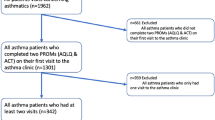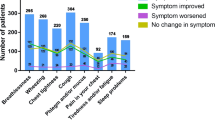Abstract
Background
To date, there is limited psychometric evidence on the Asthma Quality of Life Questionnaire (AQLQ12 +) among populations that include adolescents and adults.
Objective
To provide evidence of the psychometric properties of the AQLQ12+ as a measure of asthma-specific quality of life (QOL) in patients with persistent asthma treated with a combination of inhaled glucocorticoid and long-acting beta2-agonist, as well as explore the predictors of at least a minimally important AQLQ12+ improvement.
Methods
The psychometric properties of the AQLQ12+ were assessed through post hoc analysis of two large (n = 740 and 778) Phase III, randomized, double-blinded, placebo-controlled efficacy studies of mometasone furoate/formoterol fumarate (MF/F) combination compared with monotherapy in subjects with persistent asthma previously treated with either low-dose or medium-dose inhaled glucocorticoids.
Results
With 15% and 8% participation from 12- to 17-year olds, blinded trial data demonstrated excellent reproducibility (ICC range: 0.76–0.85) and moderate-to-strong construct validity with other measures of asthma health at baseline and over time for the AQLQ12 +. A greater percentage of the MF/F treatment group (44%) achieved an important change at 26 weeks on the AQLQ12+ compared with formoterol fumarate (F, 23%) and placebo (18%) treatment groups in the low-dose study (P < 0.001) and the medium-dose study (50% (MF/F) versus 34% (F) and 23% (placebo); P < 0.001). Pre-randomization nighttime awakenings and rescue medications use were significant predictors of AQLQ12+ improvement.
Conclusions
These findings provide strong support for the measurement properties of the AQLQ12+ among patients with persistent asthma and confidence in the AQLQ12+ improvements demonstrated by the MF/F treatment group.
Similar content being viewed by others
Abbreviations
- ACQ:
-
Asthma Control Questionnaire
- AQLQ12+:
-
Asthma quality of life questionnaire with standardized activities (12 and older)
- AQLQ(S):
-
Asthma quality of life questionnaire-standardized version
- BID:
-
Twice a day
- CI:
-
Confidence interval
- COPD:
-
Chronic obstructive pulmonary disease
- F:
-
Formoterol fumarate
- FEV1 :
-
Forced expiratory volume in one second
- HIV:
-
Human immunodeficiency virus
- ICC:
-
Intraclass correlation coefficient
- MDI:
-
Metered dose inhaler
- MID:
-
Minimal important difference
- MF:
-
Mometasone furoate
- MF/F:
-
Mometasone furoate/formoterol fumarate
- PEF:
-
Peak expiratory flow
- QOL:
-
Quality of life
- SAS:
-
Statistical analysis software
References
Global Initiative for Asthma (GINA). Global strategy for asthma management and prevention (updated 2008). Available at: http://www.ginasthma.org/Guidelineitem.asp??l1=2&l2=1&intId=60.
Gergen, P. J., Arbes, S. J., Jr., Calatroni, A., Mitchell, H. E., & Zeldin, D. C. (2009). Total IgE levels and asthma prevalence in the US population: Results from the National Health and Nutrition examination survey 2005–2006. The Journal of allergy and clinical immunology, 124(3), 447–453.
Mannino, D. M., Homa, D. M., Akinbami, L. J., Moorman, J. E., Gwynn, C., & Redd, S. C. (2002). Surveillance for asthma–United States, 1980–1999. MMWR Surveill Summ, 51(1), 1–13.
Juniper, E. F., Svensson, K., Mork, A. C., & Stahl, E. (2005). Modification of the asthma quality of life questionnaire (standardised) for patients 12 years and older. Health Qual Life Outcomes, 3, 58.
Juniper, E. F., Buist, A. S., Cox, F. M., Ferrie, P. J., & King, D. R. (1999). Validation of a standardized version of the asthma quality of life questionnaire. Chest, 115(5), 1265–1270.
Mancuso, C. A., Rincon, M., McCulloch, C. E., & Charlson, M. E. (2001). Self-efficacy, depressive symptoms, and patients’ expectations predict outcomes in asthma. Medical Care, 39(12), 1326–1338.
Almada Lobo, F., & Almada-Lobo, B. (2008). Quality of life in asthmatic outpatients. Journal of Asthma, 45(1), 27–32.
Apter, A. J., Reisine, S. T., Affleck, G., Barrows, E., & ZuWallack, R. L. (1999). The influence of demographic and socioeconomic factors on health-related quality of life in asthma. The Journal of allergy and clinical immunology, 103(1 Pt 1), 72–78.
(July 2007). National heart, lung, and blood institute. Expert panel report 3: Guidelines for the diagnosis and management of asthma. Bethesda, MD, National Asthma Education and Prevention Program, National Heart, Lung and Blood Institute, National Institutes of Health.
Crapo, R. O. (1989). Reference values for lung function tests. Respiratory CRE, 34, 626–637.
Polgar, G., & Promadhat, V. (1971). Pulmonary function testing in children: Technique and standards. Philadelphia, PA: W.B. Saunders.
Nathan, R. A., Nolte, H., & Pearlman, D. S. (2010). Twenty-six-week efficacy and safety study of mometasone furoate/formoterol 200/10 microg combination treatment in patients with persistent asthma previously receiving medium-dose inhaled corticosteroids. Allergy and Asthma Proceedings, 31(4), 269–279.
Juniper, E. F., O’Byrne, P. M., Guyatt, G. H., Ferrie, P. J., & King, D. R. (1999). Development and validation of a questionnaire to measure asthma control. European Respiratory Journal, 14(4), 902–907.
van den Nieuwenhof, L., Schermer, T., Eysink, P., Halet, E., van Weel, C., Bindels, P., et al. (2006). Can the asthma control questionnaire be used to differentiate between patients with controlled and uncontrolled asthma symptoms? A pilot study. Family Practice, 23(6), 674–681.
van den Nieuwenhof, L., Schermer, T., Heins, M., Grootens, J., Eysink, P., Bottema, B., et al. (2008). Tracing uncontrolled asthma in family practice using a mailed asthma control questionnaire. Annals of Family Medicine, 6(Suppl 1), S16–S22.
Juniper, E. F., Svensson, K., Mork, A. C., & Stahl, E. (2005). Measurement properties and interpretation of three shortened versions of the asthma control questionnaire. Respiratory Medicine, 99(5), 553–558.
Santanello, N. C., Barber, B. L., Reiss, T. F., Friedman, B. S., Juniper, E. F., & Zhang, J. (1997). Measurement characteristics of two asthma symptom diary scales for use in clinical trials. European Respiratory Journal, 10(3), 646–651.
Hays, R., & Revicki, D. A. (2005). Reliability and validity (including responsiveness). In P. Fayers & R. Hays (Eds.), Assessing quality of life in clinical trials (pp. 25–39). New York: Oxford University Press.
Streiner, D. L., & Norman, G. R. (2003). Health measurement scales: A practical guide to their development and use. Oxford: Oxford University Press.
Fleiss, J. L. (1981). Statistical methods for rates and proportions. New York: Wiley.
Hinkle, D. E., Jurs, S. G., & Wiersma, W. (1988). Applied statistics for the behavioral sciences. Boston: Houghton Mifflin.
Juniper, E. F., Guyatt, G. H., Willan, A., & Griffith, L. E. (1994). Determining a minimal important change in a disease-specific quality of life questionnaire. Journal of Clinical Epidemiology, 47(1), 81–87.
Acknowledgments
Funding for this manuscript was provided by Schering-Plough Corporation, now a division of Merck and Co.
Author information
Authors and Affiliations
Corresponding author
Rights and permissions
About this article
Cite this article
Wyrwich, K.W., Ireland, A.M., Navaratnam, P. et al. Validation of the AQLQ12+ among adolescents and adults with persistent asthma. Qual Life Res 20, 903–912 (2011). https://doi.org/10.1007/s11136-010-9821-3
Accepted:
Published:
Issue Date:
DOI: https://doi.org/10.1007/s11136-010-9821-3




